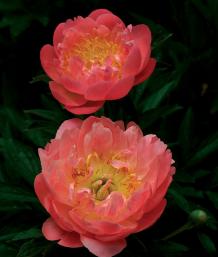
No one would deny that peonies, irises, daylilies, hostas, roses, and lilies have been stalwarts of spring and summer gardens for decades. Each of these plants has its own group of supporters, but peonies have historically garnered less praise and attention in comparison to other garden mainstays. In recent years, however, these colorful and abundant-flowering plants have been given due attention as new gardenworthy cultivars have appeared on the gardening scene.
Like all garden plants, peonies (Paeonia spp. and cvs.) got their start in the wild, primarily growing from the mountains to the sea in regions stretching from the Mediterranean to east Asia. The familiar garden or herbaceous peony group is closely related to the tree peony group and is made up of some 20 species, which grow in moderate to cold temperate climates. Several of them have been cultivated in European and Chinese gardens for hundreds of years, but it’s the selections and hybrids of these species, developed within the last 150 years, that dominate gardens today.
Classic garden peonies such as ‘Monsieur Jules Elie’ (introduced in 1888), ‘Sarah Bernhardt’ (1906), ‘Karl Rosenfield’ (1908), and ‘Festiva Maxima’ (1851) are older selections that remain popular and inexpensive. Like many early introductions, however, they are not the best garden plants. Their huge double flowers sit on weak stems, which come crashing down at the first sign of rain or even a heavy mist. These varieties need staking, and their large blooms often look out of proportion in most gardens. Breeders are selecting plants that look good and perform well in the landscape, not just in a vase. Here are some of the best gardenworthy cultivars, which offer a diverse mix of flower forms, colors, and plant sizes. They are all hardy in Zones 3 to 7.
Flower forms satisfy any taste
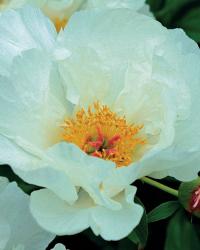
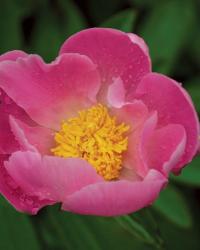
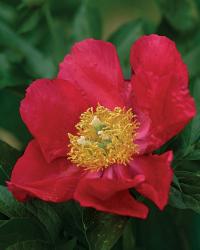
Most gardeners are aware of big, full double-flowering peonies, but more and more are coming to appreciate the simple single forms. These types of peonies stand up to rain better than the older double hybrids and are stunning in floral arrangements.
Among the all-star singles is the pure white variety ‘Krinkled White’, an outstanding, vigorous peony that reaches just over 30 inches tall. For a dose of baby ribbon pink, ‘Sea Shell’ is an excellent choice. It’s quite floriferous, and its stout 3-foot-tall stems hold its flowers well. ‘America’ is one of the very best reds and is long lasting. It looks somewhat like a single red rose, only larger. It has an upright form and reaches just over 3 feet in height.

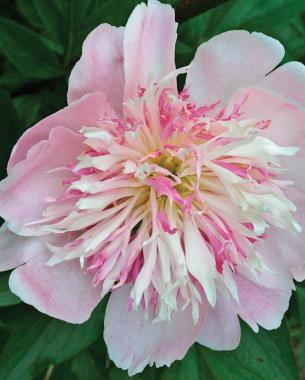
Personally, I like the semi-double peonies as well because they work perfectly in the garden and as cut flowers. There are many hybrids to choose from, but ‘Cherry Ruffles’, from award-winning hybridizer Don Hollingsworth, owner of Hollingsworth Nursery, is a great one to start with. At just over 30 inches tall, this plant’s delightful blooms have a ruffled appearance with an excellent red color. ‘Miss America’ is an abundant-flowering white semi-double with strong 3-foot-tall stems.
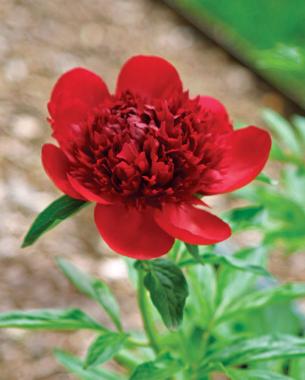
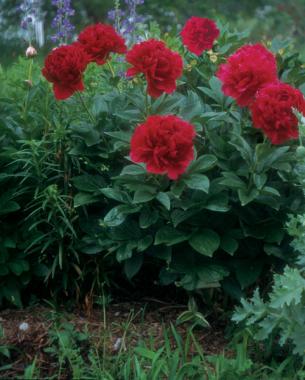
Photo/Illustration: James W. Waddick
Other forms also satisfy varying floral tastes. ‘Do Tell’, which has been classified as both a Japanese and an anemone form in peony circles, was selected as the 2005 Peony of the Year by the American Peony Society. It’s a 30-inch-tall variety with blooms that have pale pink outer petals and a dark pink-and-white center. The hybrid ‘Red Charm’, an APS gold-medal winner, is a good example of a bomb form with outstanding color. Standing on 30-inch-tall stems, the flowers have vivid red outer petals with a swollen red center.
If you must have a double-flowering peony, look for varieties that have been selected for their beautiful flowers as well as their strong stems. ‘Old Faithful’, yet another gold-medal winner, is considered one of the best doubles. In my garden, its 36-inch-tall deep red blooms keep their upright form even in wind and rain.
Herbaceous Peonies
Paeonia spp. and hybrids
(pay-OH-nee-ah)
Origins: The genus Paeonia comprises nearly 30 species (20 of which belong to the herbaceous or garden peony group) that are primarily native from the Mediterranean region to east Asia. Most garden peonies of today are the result of selection and hybridization.
Conditions: Herbaceous peonies are generally hardy in USDA Hardiness Zones 3 to 7. Plants should be given at least six hours of full sun each day. For best results, grow plants in rich, organic, well-drained soil; most prefer an alkaline pH.
Pests and Diseases: Peonies are prone to Japanese beetles and fungal diseases such as Botrytis blight. Cut foliage back to the ground in fall. Place the debris in the trash, rather than the compost pile, to prevent the spread of disease.
Propagation and planting: Propagate peonies by division. Late summer and fall, when they’re dormant, is the best time to divide, plant, or move peonies; they resent being disturbed in spring and early summer while they’re actively growing. At planting time, add compost, limestone or bone meal, sand, a light fertilizer, and other amendments suited to your soil to give your new plants a boost. Provide potted, barerooted, or divided peonies with a fairly large hole, making certain that their round pink buds (or “eyes”) are just barely covered by the soil.
Maintenance: Deadhead blooms to keep a tidy appearance, and cut back foliage after frost in fall.
On the horizon: Peony hybridizer Roy Klehm, owner of Klehm’s Song Sparrow Farm and Nursery, has recently introduced an interesting group of herbaceous peonies referred to as “cactus dahlia” forms. These peonies resemble their namesakes, with twisted and contorted petals in unusual combinations of colors. Given their descriptive names—such as ‘Silly Sally’, ‘Crazy Daisy’, and ‘Spider Green’—it will be fun to see how the distinctive nature and odd color mix of this group develop.
Unexpected colors dazzle the eye
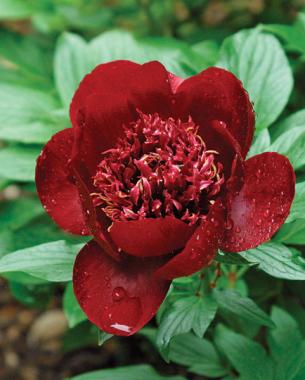
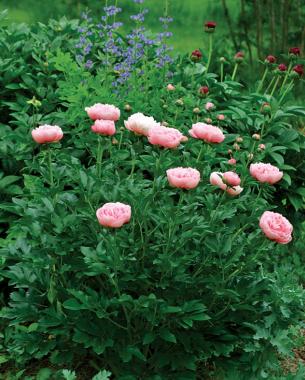
Surely nothing has shaken up the peony world as much as the introduction of new flower colors. With the basic palette of red, pink, and white, new color variations are always welcomed by gardeners. Three plants with exciting color variations are ‘Chocolate Soldier’, ‘Cytherea’, and ‘Etched Salmon’. ‘Chocolate Soldier’, a Japanese form, features deep mocha red blooms on 3-foot-tall stems. ‘Cytherea’ is an APS gold-medal winner with rich pink semi-double flowers and strong 2-foot-tall stems. ‘Etched Salmon’ has a calmer, more pink- to salmon-colored hue with a near-perfect form on 36-inch-tall stems.
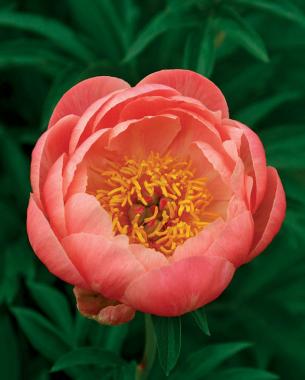
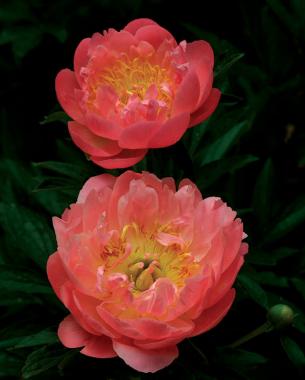
In recent years, breeders have also been dazzling peony gardeners with the introduction of coral-colored hybrids. One of the most well known is a semi-double named ‘Coral Charm’. Its blooms are a wonderfully intense coral color, and they’re supported by 28-inch-tall stems. Other noteworthy coral introductions are ‘Coral Sunset’ and ‘Pink Hawaiian Coral’. Both are award winners and reach up to 36 inches tall.
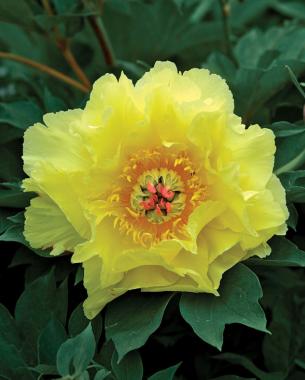
The introduction of the intersectional or Itoh hybrid peonies has also opened the door to all sorts of color options, including shades of true yellow, orange, purple, peach, and coral. These are the progeny of herbaceous and tree peonies: They have the growth habit of herbaceous peonies with the flowers and foliage of tree peonies. The semi-double yellow ‘Garden Treasure’, from Don Hollingsworth, and the near orange ‘Kopper Kettle’, from hybridizer Roger Anderson, are both knockouts. Although still rare and expensive, Itoh hybrids have peony lovers going gaga. In time, they should be easier to find and more reasonably priced as their popularity increases.
New sizes give more options


Photo/Illustration: James W. Waddick
In the wide world of peonies, there have also been a number of introductions that vary in size, from dwarf to giant. This has allowed gardeners with either big or small spaces to enjoy the glory of peonies. On the small side, ‘Elfin Beauty’ is a reddish pink hybrid that is barely over 12 inches tall. ‘Early Scout’ is a 20-inch-tall gold-medal winner, also with red flowers, while ‘Nosegay’ has silvery pink blooms on 28-inch-tall stems. Like many other peonies, all three plants have finely cut foliage, which gives them textural interest when they are not in bloom.
At the opposite end of the spectrum are a couple of excellent hybrids that tower over most perennials in the garden. ’White Innocence’ has pure white single blooms and reaches 5 feet tall; ’Chalice’ has creamy white flowers and grows to 4 feet in height. Both plants make first-rate backdrops at the back of the border. For the best effect, place these hybrids near spring-flowering plants like false indigo (Baptisia australis, Zones 3–9), columbines (Aquilegia spp. and cvs, Zones 3–8), blue stars (Amsonia tabernaemontana, Zones 3–9), and corydalis (Corydalis spp. and cvs., Zones 5–8). Irises (Iris spp. and cvs., Zones 3–9) with white markings provide a particularly nice contrasting texture when paired with the tall white-flowering peonies.
Gardeners’ glossary
Single flowers have between five and 10 petals, usually in a single ring. They’re simple and open, allowing you to see the inner floral parts: the anthers and the stigmas.
Japanese and anemone flowers are so similar to each other that they’re often judged in the same class. They also resemble single flowers, but their centers have a puff (a raised mass of petaloids) that is made up of many needlelike petals, often of contrasting colors.
Semi-double flowers have more petals than the single forms yet fewer than the double forms. They typically have two or three whorls of petals.
Double flowers are massive and have numerous ruffled petals that fill the center of the bloom.
Bomb flowers are like doubles only they have a row or two of large outer petals, which make them look like a bombe dessert.
As you can see, the future is bright for garden peonies. These plants are just a sampling of the new and novel hybrids that are available. This spring, take advantage of their bloom period and explore peonies that suit your taste and do well in your area. Choose your favorites, then dig in and plant them in fall. You are sure to be pleased and wowed by the glorious nature of these garden stalwarts.
Fine Gardening Recommended Products

A.M. Leonard Deluxe Soil Knife & Leather Sheath Combo
Fine Gardening receives a commission for items purchased through links on this site, including Amazon Associates and other affiliate advertising programs.

Wagner's 52003 Classic Blend Wild Bird Food, 6-Pound Bag
Fine Gardening receives a commission for items purchased through links on this site, including Amazon Associates and other affiliate advertising programs.


















Comments
Log in or create an account to post a comment.
Sign up Log in